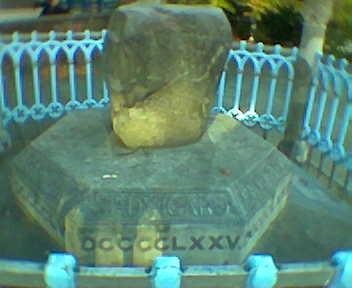
- Tod joins the locals [677] and the BBC [678] in claiming the town derives it's name from the stone. However there is evidence (also from BBC [679]) that the name Kingston derives from the Anglo-Saxon words cyninges, (later cynges) and tun, meaning 'king's estate' or 'enclosure'. It first appears in a document from around 838, written in Latin and currently housed in the British Library. Kingston refers to a 'great council at Cyningestun, that famous place in Surrey'.
- The photo has the Roman DCCCCLXXV (975) so the name above must be Edward the Martyr [680] who was murdered by supporters of his younger brother Ethelred the unready. The last coronation in Kingston was that of Ethelred II in 979 AD [678] and, I believe listed on the plaque beside the Kings' Stone [681], but other records have Ethelred II crowned a month after the murder in 978 [680]).
Justice appears to have been served by History and while Edward achieved Sainthood, Ethelred the unready (illadvised) comes down in history as the King who destroyed the prestidge of the crown and failed to prevent Danish invasions.
The significance of the "Kings' Stone" in Kingston-upon-Thames was brought to my attention by Oscar MITCHELL [639]